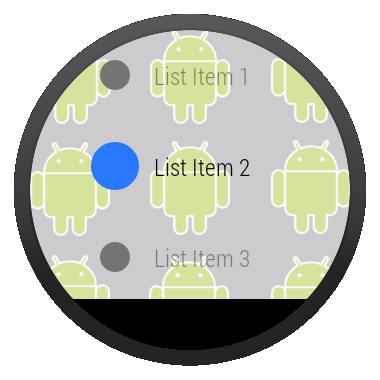創建List
編寫: roya 原文:https://developer.android.com/training/wearables/ui/lists.html
List讓用戶在可穿戴設備上很容易地從一組選項中選擇一個項目。這個課程介紹瞭如何在Android Wear應用中創建List。
Wearable UI庫包含了WearableListView類,該類是對可穿戴設備進行優化的List實現。
Note: Android SDK 中的
Notifications例子示範瞭如何在應用中使用WearableListView。這個例子的位於android-sdk/samples/android-20/wearable/Notifications目錄。
為了在Android Wear應用中創建List,我們需要:
- 添加
WearableListView元素到activity的layout定義中。 - 為List選項創建一個自定義的layout實現。
- 使用這個實現為List選項創建一個layout定義文件。
- 創建一個adapter以填充List。
- 指定這個adapter到
WearableListView元素。
下面的章節有這些步驟的詳細描述。
Figure 3: 在Android Wear上的List View.
添加List View
下面的layout使用BoxInsetLayout添加了一個List view到activity中,所以這個List可以正確地顯示在圓形和方形兩種設備上:
<android.support.wearable.view.BoxInsetLayout
xmlns:android="http://schemas.android.com/apk/res/android"
xmlns:app="http://schemas.android.com/apk/res-auto"
android:background="@drawable/robot_background"
android:layout_height="match_parent"
android:layout_width="match_parent">
<FrameLayout
android:id="@+id/frame_layout"
android:layout_height="match_parent"
android:layout_width="match_parent"
app:layout_box="left|bottom|right">
<android.support.wearable.view.WearableListView
android:id="@+id/wearable_list"
android:layout_height="match_parent"
android:layout_width="match_parent">
</android.support.wearable.view.WearableListView>
</FrameLayout>
</android.support.wearable.view.BoxInsetLayout>
為List選項創建一個Layou實現
在許多例子中,每個List選項都由一個圖標和一個描述組成。Android SDK中的Notifications 例子實現了一個自定義layout:繼承LinearLayout以合併兩元素到每個List選項。這個layout也實現了 WearableListView.OnCenterProximityListener接口裡的方法,以實現在用戶在List中滾動時,因WearableListView的事件而改變選項圖標顏色和漸隱文字:
public class WearableListItemLayout extends LinearLayout
implements WearableListView.OnCenterProximityListener {
private ImageView mCircle;
private TextView mName;
private final float mFadedTextAlpha;
private final int mFadedCircleColor;
private final int mChosenCircleColor;
public WearableListItemLayout(Context context) {
this(context, null);
}
public WearableListItemLayout(Context context, AttributeSet attrs) {
this(context, attrs, 0);
}
public WearableListItemLayout(Context context, AttributeSet attrs,
int defStyle) {
super(context, attrs, defStyle);
mFadedTextAlpha = getResources()
.getInteger(R.integer.action_text_faded_alpha) / 100f;
mFadedCircleColor = getResources().getColor(R.color.grey);
mChosenCircleColor = getResources().getColor(R.color.blue);
}
// Get references to the icon and text in the item layout definition
@Override
protected void onFinishInflate() {
super.onFinishInflate();
// These are defined in the layout file for list items
// (see next section)
mCircle = (ImageView) findViewById(R.id.circle);
mName = (TextView) findViewById(R.id.name);
}
@Override
public void onCenterPosition(boolean animate) {
mName.setAlpha(1f);
((GradientDrawable) mCircle.getDrawable()).setColor(mChosenCircleColor);
}
@Override
public void onNonCenterPosition(boolean animate) {
((GradientDrawable) mCircle.getDrawable()).setColor(mFadedCircleColor);
mName.setAlpha(mFadedTextAlpha);
}
}
我們也可以創建animator對象以放大List中間選項的圖標。我們可以使用WearableListView.OnCenterProximityListener接口的onCenterPosition()和 onNonCenterPosition()回調方法來管理animator對象。更多關於animator對象的信息請查看Animating with ObjectAnimator
##為Items創建Layout解釋
在為List選項實現自定義layout之後,我們需要提供一個layout解釋文件以具體說明list item中的組件參數。下面的layout使用先前的自定義layout實現,並且定義圖標和文本view,這兩個view的ID對應layout實現類的ID:
res/layout/list_item.xml
<com.example.android.support.wearable.notifications.WearableListItemLayout
xmlns:android="http://schemas.android.com/apk/res/android"
android:gravity="center_vertical"
android:layout_width="match_parent"
android:layout_height="80dp">
<ImageView
android:id="@+id/circle"
android:layout_height="20dp"
android:layout_margin="16dp"
android:layout_width="20dp"
android:src="@drawable/wl_circle"/>
<TextView
android:id="@+id/name"
android:gravity="center_vertical|left"
android:layout_width="wrap_content"
android:layout_marginRight="16dp"
android:layout_height="match_parent"
android:fontFamily="sans-serif-condensed-light"
android:lineSpacingExtra="-4sp"
android:textColor="@color/text_color"
android:textSize="16sp"/>
</com.example.android.support.wearable.notifications.WearableListItemLayout>
創建Adapter以填充List
Adapter用內容填充WearableListView。下面的adapter基於strings數組元素填充了List:
private static final class Adapter extends WearableListView.Adapter {
private String[] mDataset;
private final Context mContext;
private final LayoutInflater mInflater;
// Provide a suitable constructor (depends on the kind of dataset)
public Adapter(Context context, String[] dataset) {
mContext = context;
mInflater = LayoutInflater.from(context);
mDataset = dataset;
}
// Provide a reference to the type of views you're using
public static class ItemViewHolder extends WearableListView.ViewHolder {
private TextView textView;
public ItemViewHolder(View itemView) {
super(itemView);
// find the text view within the custom item's layout
textView = (TextView) itemView.findViewById(R.id.name);
}
}
// Create new views for list items
// (invoked by the WearableListView's layout manager)
@Override
public WearableListView.ViewHolder onCreateViewHolder(ViewGroup parent,
int viewType) {
// Inflate our custom layout for list items
return new ItemViewHolder(mInflater.inflate(R.layout.list_item, null));
}
// Replace the contents of a list item
// Instead of creating new views, the list tries to recycle existing ones
// (invoked by the WearableListView's layout manager)
@Override
public void onBindViewHolder(WearableListView.ViewHolder holder,
int position) {
// retrieve the text view
ItemViewHolder itemHolder = (ItemViewHolder) holder;
TextView view = itemHolder.textView;
// replace text contents
view.setText(mDataset[position]);
// replace list item's metadata
holder.itemView.setTag(position);
}
// Return the size of your dataset
// (invoked by the WearableListView's layout manager)
@Override
public int getItemCount() {
return mDataset.length;
}
}
連接Adapter和設置Click Listener
在我們的activity中,從layout中取得WearableListView元素的引用,分配一個adapter實例以填充List,然後設置一個click listener以完成當用戶選擇了一個特定的List選項的動作。
public class WearActivity extends Activity
implements WearableListView.ClickListener {
// Sample dataset for the list
String[] elements = { "List Item 1", "List Item 2", ... };
@Override
protected void onCreate(Bundle savedInstanceState) {
super.onCreate(savedInstanceState);
setContentView(R.layout.my_list_activity);
// Get the list component from the layout of the activity
WearableListView listView =
(WearableListView) findViewById(R.id.wearable_list);
// Assign an adapter to the list
listView.setAdapter(new Adapter(this, elements));
// Set a click listener
listView.setClickListener(this);
}
// WearableListView click listener
@Override
public void onClick(WearableListView.ViewHolder v) {
Integer tag = (Integer) v.itemView.getTag();
// use this data to complete some action ...
}
@Override
public void onTopEmptyRegionClick() {
}
}
